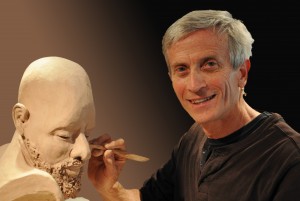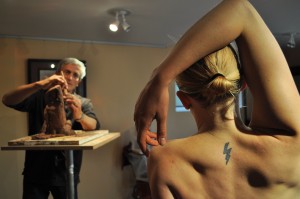David Varnau
 For me, the genesis of each new sculpture is my desire to capture the wonder and appreciation that I feel when I witness anew the beauty of the human form. What inspires me may be a pose that a model strikes that conveys a mood that I find compelling. Or, during the course of my day, I may observe someone in public whose features or stance prompts me to return to my studio to render what caught my interest. Having chosen the subject matter, I begin by deciding the scale of the sculpture. Do I want to create a table top size or much larger piece? That decision than drives the next step, which is to create an armature that will support the clay figure later. The armature may be very simple or, in the case of life size sculptures, it may involve engineering and welding a very strong rebar framework.
For me, the genesis of each new sculpture is my desire to capture the wonder and appreciation that I feel when I witness anew the beauty of the human form. What inspires me may be a pose that a model strikes that conveys a mood that I find compelling. Or, during the course of my day, I may observe someone in public whose features or stance prompts me to return to my studio to render what caught my interest. Having chosen the subject matter, I begin by deciding the scale of the sculpture. Do I want to create a table top size or much larger piece? That decision than drives the next step, which is to create an armature that will support the clay figure later. The armature may be very simple or, in the case of life size sculptures, it may involve engineering and welding a very strong rebar framework.
Then, with a live model before me, I am ready to begin carving the figure in clay. Unlike what a 2-D artist would do, I rotate my model periodically so that I can see her or him from  different perspectives to ensure that the sculpture is accurate from all sides. This also serves to inform me as to how I might change the pose in order to create greater visual interest as the sculpture is later seen by the viewer. Typically, the model poses for me for a duration of between twenty and fifty hours, not only because of my passion for accuracy, but also due to my aspiration to have every detail ultimately elicit the desired visceral response in the viewer. Many of my sculptures are nude, some are not. But all are originally sculpted from a live nude model in order to capture the anatomy of the subject. If the sculpture is to have drapery on it, that is added at the end. Often, I may change the mood of the piece with a few subtle changes to the corner of the mouth and cheeks, the gesture of the hands or even with the way the clothing flows.
different perspectives to ensure that the sculpture is accurate from all sides. This also serves to inform me as to how I might change the pose in order to create greater visual interest as the sculpture is later seen by the viewer. Typically, the model poses for me for a duration of between twenty and fifty hours, not only because of my passion for accuracy, but also due to my aspiration to have every detail ultimately elicit the desired visceral response in the viewer. Many of my sculptures are nude, some are not. But all are originally sculpted from a live nude model in order to capture the anatomy of the subject. If the sculpture is to have drapery on it, that is added at the end. Often, I may change the mood of the piece with a few subtle changes to the corner of the mouth and cheeks, the gesture of the hands or even with the way the clothing flows.
The process of actually sculpting is nearly mystical for me. I simply revel in the transference of the visual details to my hands as they model the clay. I find myself drop into a zone that is both generative and profound. Further, there is a communion that develops between me and the model as I discover visually the contours of her body or the lines of his motion. I know that I am in the groove when I become excited about the pose. When viewing the completed clay original, I must feel stirred by the mood that the sculpture conveys. I have a confidence of it being complete when the sensuality and dynamism of the piece is compelling. It is only then that I commit to casting the sculpture in bronze.
To transform my clay art into a cast bronze sculpture involves four major steps at a foundry. This multi-staged, labor intensive mold making and bronze casting process yields a nearly indestructible work of art whose original source of inspiration will continue to resonate with viewers for generations.
David Varnau
davidvarnau.com
